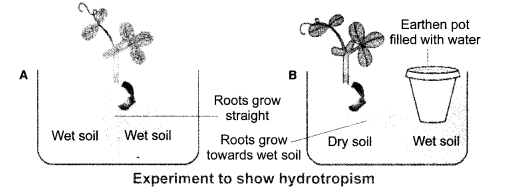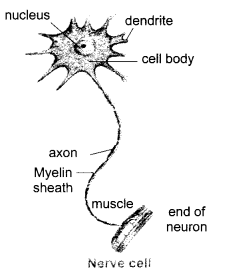NCERT Solutions for Class 10 Science chapter 7 Control and Coordination : The chapter teach you about control and coordination which are the functions of the nervous system and hormones in our bodies. The responses of the nervous system can be classified as a reflex action, voluntary action or involuntary action. Students who are preparing for their Class 10 exams and searching for chapter-wise NCERT Solution for Class 10 Science must go through NCERT Solutions for Class 10 Science Chapter 7 Control and Coordination. You can also check NCERT Solution for Class 9 Maths.
- Control And Coordination
- Animals – Nervous System
- Coordination In Plants
- Hormones In Animals
ALSO CHECK – NCERT Solutions for Class 10 Maths
ALSO CHECK – Download the free Class 10th Notes here
These NCERT Solution for Class 10 Science Chapter 7 Control and Coordination is prepared by our best subject experts teachers group thats help students to understand all the topics easily. With the help of these NCERT Solution for Class 10 Science, students can understand the complex topics of class 10 science. We all know Science is a subject that needs a clear understanding of the concepts and topics to score well in it.
NCERT Solutions for Class 10 Science chapter 7 Control and Coordination Intext Questions
Page number 119
Question 1
What is the difference between a reflex action and walking?
Answer:
| Reflex action | Walking |
| 1. It is the action which is performed automatically. | 1. It is a response to the information transmitted by nerve to muscles of the legs. In this case, thinking is involved. |
| 2. It is controlled and coordinated by spinal cord. | 2. Brain instructs and controls leg muscles to move. |
| 3. It is an involuntary action. | 3. It is a voluntary action. |
Question 2
What happens at the synapse between two neurons?
Answer:
The small empty space between two nerve cells is called synapse. At synapse, a chemical substance is produced at the end of axon of one nerve cell that reaches to the other nerve cell through the dendrite. Thus, information is transmitted from one nerve cell to other nerve cell by synapse.
Question 3
Which part of the brain maintains posture and equilibrium of the body ?
Answer:
Cerebellum which is a part of the brain is responsible for Controls the motor functioning hence it is the part reengaged in the maintenance of posture and equilibrium of the body.
Question 4
How do we detect the smell of an agarbatti (incense stick) ?
Answer:
Smell of an agarbatti is detected by nose, olfactory receptors present in the nose sends electrical signal to the fore brain. Fore brain interprets this signal as the incense stick to be detected as smell.
Question 5
What is the role of the brain in reflex action ?
Answer:
There is no role of brain in reflex action. These involuntary actions are controlled by the spinal cord which take place immediately without thinking of how to respond to the stimuli.
Page Number: 122
Question 1
What are plant hormones ?
Answer:
Plant hormones, also known as phytohormones, are naturally occurring chemical compounds that govern plant cell growth and metabolism. These are made in one section of the plant’s body and then moved to other parts as needed. Auxins, gibberellins, cytokinin, abscisic acid, and ethylene are the five major types of plant hormones.
Different types of phytohormones are – auxins, gibberllins, cytokinins, abscisic acid and ethylene.
Question 2
How is the movement of leaves of the sensitive plant different from the movement of a shoot towards light ?
Answer:
| Movement of leaves of sensitive plant | Movement of a shoot towards light |
| 1. It is a nastic movement which does not depend on the direction of stimulus applied. | 1. It is a tropic movement which depends on the direction of stimulus applied. |
| 2. The stimulus is touch. | 2. The stimulus is light. |
| 3. It is caused by the sudden loss of water from the swellings at the base of leaves. | 3. It is caused by the unequal growth on the two sides of the shoot. |
| 4. It is not a growth movement. | 4. It is a growth movement. |
Question 3
Give an example of a plant hormone that promotes growth.
Answer:
Auxin is an example of a plant hormone that promotes growth.
Question 4
How do auxins promote the growth of a tendril around a support ?
Answer:
When the tip of a tendril touches a support, then the auxins present in its tip move to that side of tip which is away from the support. Auxins promote growth. So, due to more auxins in it, the side of tendril away from the support grows faster (and becomes longer) than the side which is in contact with the support and makes the tendril twirl (or bend) around the support.
Question 5
Design an experiment to demonstrate hydrotropism.
Answer:
Procedure :
i. Plant a seedling in a vessel containing soil.
ii. Adjacent to the seedling put a porous pot containing water.
iii. Leave the set up for few days.
Observation :
iv. On examining the roots it is observed that the roots bend towards the source of water and do not grow straight.
Result :
It confirms that plant shows hydrotropism as the roots bend towards the porous pot of water. As hydrotropism is a plant growth response in which the direction of growth is determined by a stimulus of gradient in water concentration.

Page Number: 125
Question 1
How does chemical coordination take place in animals ?
Answer:
Chemical coordination in animals takes place through the hormones secreted by the endocrine glands. Coordination in animals takes place through hormone system as well as nervous system which is called endocrine system. Endocrine glands secrete animal hormones directly into the blood that reach to the specific cells. Special type of molecules are present on the surface of cells to detect these hormones. These cells act according to the information that a particular hormone carries.
Question 2
Why is the use of iodised salt advisable ?
Answer:
To avoid the deficiency of Iodine. If the intake of iodine is low, the release of thyroxine from the thyroid gland will be decreased. This affects fat, carbohydrate and protein metabolism. Thus a person may have goitre problem in case if the intake of iodine is lowered.
Question 3
How does our body respond when adrenaline is secreted into the blood ?
Answer:
The heart beat increases when adrenaline is secreted into the blood so that more oxygen is supplied to our muscles. The blood supply to the digestive system and skin decreases because the small arteries around the muscles of these organs contract. This turns the direction of blood towards our skeletal muscles. The breathing rate also increases due to the contractions of the diaphragm and rib muscles. All these responses enable us to face the situations of fear and anger.
Question 4
Why are some patients of diabetes treated by giving injections of insulin ?
Answer:
The level of sugar in the blood (glucose) is too high in diabetes mellitus. Insulin is a hormone produced by the pancreas that aids in blood sugar regulation by converting excess glucose to glycogen in the liver. The amount of insulin released by the pancreas is insufficient to convert glucose to glycogen in these people. It is for this reason that diabetic patients are treated with insulin injections.
NCERT Solutions for Class 10 Science Chapter 7 Textbook Chapter End Questions
Page number 126
Question 1
Which of the following is a plant hormone?
(a) Insulin
(b) Thyroxin
(c) Oestrogen
(d) Cytokinin
Answer:
(d) Cytokinin
Question 2
The gap between two neurons is called a
(a) dendrite
(b) synapse
(c) axon
(d) impulse
Answer:
(b) Synapse
Question 3
The brain is responsible for
(a) thinking
(b) regulating the heart beat
(c) balancing the body
(d) all of the above
Answer:
(b) All of the above
Question 4
What is the function of receptors in our body ? Think of situations where receptors do not work properly. What problems are likely to arise ? [AICBSE 2016]
Answer:
Receptors are present throughout our body mainly sense organs. Receptors collect the information about changes that happen around us and send the signal to information to brain which render effector mechanism against the change. When receptors do not work properly, the environmental stimuli are not able to create nerve impulses and body does not respond.
Question 5
Draw the structure of a neuron and explain its function. [AICBSE 2017]
Answer:
Nerve cell or neuron is the functional unit of nervous system. A nerve cell has three parts-
(i) cell body
(ii) dendrite
(iii) axon
Function : The function of nerve cells is to carry information in the form of electrical signals which are called nerve impulses. Cells receive stimulus to send it to spinal cord and brain and carry the message from brain to the target organ.
Question 6
How does phototropism occur in plants ?
Answer:
The movement in any part of a plant due to light is called phototropism. The shoot of plant shows positive phototropism and roots show negative phototropism.
Phototropism in plants occurs due to the hormone auxin. When light falls on one side of a plant, the secretion of auxin hormone is more in the part away from the light. Hence, auxin causes growth in length of the cells in shady part. So, the plant appears to bend towards light.
Question 7
Which signals will get disrupted in case of a spinal cord injury ?
Answer:
All nerve signalling will be disrupted if the spinal cord is injured. This will have an impact on the transmission of impulses from receptors to the brain, as well as the brain’s reaction to effectors, particularly motor neurons.
Question 8
How does chemical coordination occur in plants ?
Answer:
Chemical coordination in plants takes place with the help of plant hormones. In most of the regions where division takes place (meristematic regions) stimuli cells secrete chemical compounds (hormone). These substances identify the information by stimulating the other nearby cells and communicating the information.
Question 9
What is the need for a system of control and coordination in an organism ?
Answer:
Coordination is the process of maintaining body functioning in response to changes in the body by working together for distinct integrated body systems. All of the motions that occur as a result of stimuli must be meticulously coordinated and controlled. Controlling how you react to stimuli aids in the development of more efficient response mechanisms. When all of the stimuli and their effects are taken into account, the organism’s ability to function efficiently is dependent on the coordination of numerous reactions. As a result, multiple physiological processes and responses must be synchronised. The neurological and muscular systems in animals offer movement control and coordination. Phytohormones are responsible for controlling and coordinating plant behaviour.
Question 10
How are involuntary actions and reflex actions different from each other ?
Answer:
| Involuntary actions | Reflex actions |
| 1. Those actions which occur immediately without any thinking are called involuntary actions. | 1. Reflex action is an immediate response to an event which does not require any processing by brain. |
| 2. Involuntary actions are controlled by mid and hind brain. Example: Breathing, beating of heart, etc. | 2. Reflex actions are controlled by spinal cord. Example: Sneezing, coughing, etc. |
Question 11
Compare and contrast nervous and hormonal mechanisms for control and coordination in animals.
Answer:
| Nervous mechanism | Hormonal mechanism |
| It is consist of nerve impulses between PNS, CNS and Brain. | It consists of endocrine system which secretes hormones directly into blood. |
| Response time is very short. | Response time is very long. |
| Nerve impulses are not specific in their action. | Each hormone has specific actions. |
| The flow of information is rapid. | The flow of information is very slow. |
| Growth is not affected. | Growth is affected. |
Question 12
What is the difference between the manner in which movement takes place in a sensitive plant and the movement in our legs ?
Answer:
| Movement in a sensitive (mimosa) plant | Movement in legs of a human |
| 1. The leaves of a sensitive plant like mimosa are sensitive to touch. | 1. Leg is in control of nerve muscles. |
| 2. It is not controlled by any part of the plant. | 2. It is controlled by brain and spinal cord. |
| 3. In this, cells change their shape on changing the amount of water in them. | 3. Amount of water has no effect on the movement of muscles. |
| changing the amount of water in them. | the movement of muscles. |
| 4. The movement in a sensitive plant are nastic movement. | 4. The movement in our leg is due to voluntary nervous system. |







